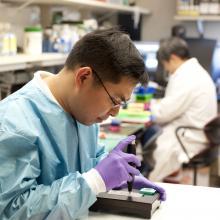The Need
A tissue microarray (TMA) is a tool used by pathologists to accurately examine tissue samples obtained from patients. It is a means of aggregating the samples in an organized grid fashion for high-throughput analysis. Automated TMAs are commercially available, but they are expensive ($16,000-$230,000) and require specialized training and experience. A technology that avoids the cost and training of existing commercial tissue microarrays was invented at the National Cancer Institute (NCI), and was recently transferred to the market. The new technology offers a simplified, manual, low-cost alternative that can be used in clinical and research settings to validate the immunohistochemical assays required for cancer diagnosis.
The Inventor
The NCI recognized the value of expanding global access to microarray technology as a quality assurance imperative.It noted the benefit such a tool could bring to hospitals and research centers across the globe. At the forefront of this effort was Dr. Stephen Hewitt, a Staff Clinician in the NCI Laboratory of Pathology, who first conceived of this invention after observing that the community needed a simpler and more affordable instrument for the discovery and validation of biomarkers that will themselves ultimately improve cancer research and diagnosis.
The Collaboration and Technology Transfer Result
Once patented, the NCI Technology Transfer Center identified that the commercialization of the technology could be well-served by the Small Business Innovation Research Technology Transfer (SBIR-TT) program, which allows close collaboration between the awarded companies and NCI scientists. The technology was released as a contract solicitation topic for the SBIR-TT, and a Phase I NCI SBIR contract was awarded in September, 2012 to Micatu, Inc. Micatu completed Phase I feasibility testing and was later awarded an NCI Phase II SBIR grant in June 2014.
The transfer of this NCI technology to the market highlights the use of the SBIR-TT mechanism to transform a patented NCI invention into a commercialized product. The commercialization of this instrument provides researchers and pathologists access to a technology that was not previously accessible because of technical complexity and significant cost. Beginning with Dr. Hewitt’s original 2003 drawing, Micatu has begun to commercialize a high quality, precision instrument with functional and speed capabilities that rival automated instruments costing from 8- to 30 times more.
The “MicaArray Gen 3.0,” likened to a “histology lab in a box,” operates without power, which facilitates its use in the field. Through the vision of Dr. Hewitt and the engineering know-how of Micatu, the result of this technology transfer is an affordable, turnkey instrument that gives investigators the ability to construct their own TMAs rather than having to send samples to a core service laboratory or purchase expensive equipment. In addition, Micatu is leveraging remarkable advances in 3D printing technology to manufacture the product at a low cost that does not impede business profitability. In doing so, they have essentially created a new business model to take the product to market. Micatu is able to print the MicaArray on demand and customize orders, and avoid the expense of carrying a high inventory. This manufacturing advance supports the solution that Dr. Hewitt sought - an affordable instrument that can be widely accessed.
Commercialization of this instrument provides researchers and pathology laboratories access to a technology that was not previously accessible because of technical complexity and significant cost.
